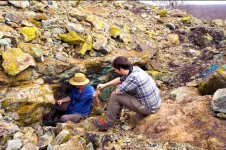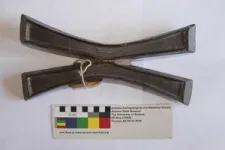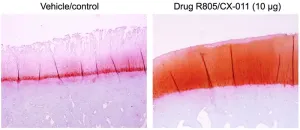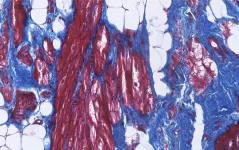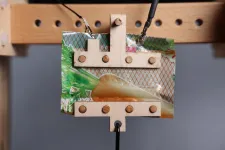(Press-News.org) COLUMBIA, Mo. – Chemical and isotopic analysis of copper artifacts from southern Africa reveals new cultural connections among people living in the region between the 5th and 20th centuries according to a University of Missouri researcher and colleagues.
People in the area between northern South Africa and the Copperbelt region in central Africa were more connected to one another than scholars previously thought, said Jay Stephens, a post-doctoral fellow in the MU Research Reactor (MURR) Archaeometry Lab.
“Over the past 20 to 30 years, most archaeologists have framed the archaeological record of southern Africa in a global way with a major focus on its connection to imports coming from the Indian Ocean,” he said. “But it’s also important to recognize the interconnected relationships that existed among the many groups of people living in southern Africa. The data shows the interaction between these groups not only involved the movement of goods, but also flows of information and the sharing of technological practices that come with that exchange.”
Mining copper ore
For years, scholars debated whether these artifacts, called rectangular, fishtail and croisette copper ingots, were made exclusively from copper ore mined in the Copperbelt region or from Zimbabwe’s Magondi Belt. As it turns out, both theories are correct, Stephens said.
“We now have tangible linkages to reconstruct connectivity at various points in time in the archeological record,” he said. “There is a massive history of interconnectivity found throughout the region in areas now known as the countries of Zambia, Zimbabwe and the Democratic Republic of the Congo. This also includes people from the contemporary Ingombe Ilede, Harare, and Musengezi traditions of northern Zimbabwe between at least the 14th and 18th centuries A.D.”
To determine their findings, researchers took small samples from 33 copper ingots and analyzed them at the University of Arizona. All samples were carefully selected by researchers from archeological samples found in the collections of the Museum of Human Sciences in Harare, Zimbabwe, and the Livingstone Museum in Livingstone, Zambia.
“We didn’t want to impact the display of an object, so we tried to be aware of how museums and institutions would want to interact with the data we collected and share it with the general public,” Stephens said. “We also want our knowledge to be accessible for the individuals in these communities who continue to interact with these objects. Hopefully, some of the skills linked with these analyses can be used by whomever wants to ask similar questions in the future.”
Stephens said copper ingots are excellent objects for this type of analysis because they often have emblematic shapes that allow archaeologists to identify specific markings and follow changes over different time periods.
“By looking at their changes in shape and morphology over time, we can pair those changes with how technology changed over time,” he said. “This often comes from observing the decorative features produced from the cast object or mold, or other surface attributes found on these objects.”
Gathering scientific evidence
Once the samples arrived at the University of Arizona lab, researchers took a small amount of each sample — less than one gram — and dissolved it with specific acids to leave behind a liquid mixture of chemical ions. Then the samples were analyzed for lead isotopes and other chemical elements. One challenge the team encountered was a lack of existing data to match their samples with.
"One part of the project included analyzing hundreds of ore samples from different geological deposits in southern Africa — especially ones mined before the arrival of European colonial forces — to create a robust data set,” Stephens said. “The data can provide a scientific foundation to help back up the inferences and conclusions we make in the study.”
Historical connections
Stephens said the data they collect is one of the only remaining tangible links that exist today to those precolonial mines in Africa.
“Unfortunately, large open pit mines have destroyed a lot of the archaeological sites and broader cultural landscapes around these geological deposits,” he said. “This makes it a challenge to reconstruct the history related to these mines. It’s a concerning development, especially with the global push toward more electric vehicles which use minerals like copper and cobalt found in the Copperbelt.”
“Reconstructing the geological provenance and long-distance movement of rectangular, fishtail, and croisette copper ingots in iron age Zambia and Zimbabwe,” was published in PLOS ONE. Co-authors are David Killick at the University of Arizona and Shadreck Chirikure at the University of Oxford and University of Cape Town. This study was supported by a grant from the National Science Foundation. The content is solely the responsibility of the authors and does not necessarily represent the official views of the funding agencies.
Editor's Note: Stephens and his colleagues have applied for an additional grant to allow them to analyze copper ingots from other sites in South Africa and Malawi that were not included in the current project. The data collected will be used to help address any knowledge gaps they identify in their current research. All work for the next phase of the project will be done at the MU Research Reactor (MURR) Archaeometry Lab.
“MU has done an amazing job of creating a center for archeological science at MURR,” Stephens said. “I think that’s fantastic because it lets researchers be as creative as they want in asking questions about their research because of the number of different tools that are available to help answer those questions.”
END
Copper artifacts unearth new cultural connections in southern Africa
A University of Missouri researcher and colleagues use geochemical analyses on copper objects to reveal centuries of previously unknown connections within the region.
2023-03-22
ELSE PRESS RELEASES FROM THIS DATE:
Babies or beauty?
2023-03-22
Have you ever marveled at the vast diversity of life on our planet, from tiny creatures living only a few hours to majestic beings that can survive for centuries? These differences in lifespan, size, and reproductive age are known as life-history strategies, and they have evolved over time as organisms adapt to their environments.
Evolutionary biologists have long been interested in understanding the factors that contribute to the evolution and maintenance of multiple alternative life-history strategies (ALHS) within species that lead to adaptation and novel traits. A new study published in Science Advances has not only revealed that an ALHS in Colias ...
The Protein Society announces its 2023 award winners
2023-03-22
FOR IMMEDIATE RELEASE
March 22, 2023
THE PROTEIN SOCIETY ANNOUNCES ITS 2023 AWARD RECIPIENTS
LOS ANGELES, CA – The Protein Society, the premier international society dedicated to supporting protein research, announces the winners of the 2023 Protein Society Awards, which will be conferred at the 37th Anniversary Symposium, July 13 – 16, 2023, in Boston, Massachusetts. Plenary talks from select award recipients will take place throughout the 3.5-day event. The scientific accomplishments of the awardees, highlighted here as described by their nominators, demonstrate their lasting impact on protein science.
The Carl Brändén Award, sponsored by Rigaku ...
Road noise makes your blood pressure rise – literally
2023-03-22
If you live near a busy road you might feel like the constant sound of roaring engines, honking horns and wailing sirens makes your blood pressure rise. Now a new study published today in JACC: Advances confirms it can do exactly that.
Previous studies have shown a connection between noisy road traffic and increased risk of hypertension. However, strong evidence was lacking, and it was unclear whether noise or air pollution played a bigger role. The new research shows that it is exposure to road traffic noise itself that can elevate hypertension risk.
“We were a ...
Potential relief for osteoarthritis moves to clinical trial after animal studies
2023-03-22
A team of researchers at the Keck School of Medicine of USC have found a drug with the potential for curbing painful hyperinflammation from osteoarthritis, according to results of an animal study.
The findings, published March 22nd in Science Translational Medicine, indicate that a drug compound, R805/CX-011, may modulate an important cell receptor in the body’s immune system, GP130, that signals when antibodies should attack a virus or infection. The animal model studies showed that the drug compound can disrupt the receptor’s over-activation of inflammation, and still manage pain ...
Racial disparities in US drug overdose fatalities significantly higher in 2020
2023-03-22
The first year of the COVID pandemic saw significant increases in drug overdose deaths across the USA, with rates higher than recent trends could have predicted. Research published in the open access journal PLOS Global Public Health, reports trends in drug overdose deaths between 2013-20 across four major drug categories by gender, race and geography. It finds high levels of heterogeneity in overdose patterns across different demographic groups and that the gap in overdose fatalities between black and white individuals continues to widen. Drug prevention and mitigation campaigns should therefore be tailored to specific at-risk groups.
Drug overdose deaths have been ...
From mutation to arrhythmia: desmosomal protein breakdown as an underlying mechanism of cardiac disease
2023-03-22
Mutations in genes that form the desmosome are the most common cause of the cardiac disease arrhythmogenic cardiomyopathy (ACM), which affects one in 2000 to 5000 people worldwide. Researchers from the group of Eva van Rooij now discovered how a mutation in the desmosomal gene plakophilin-2 leads to ACM. They found that the structural and functional changes in ACM hearts caused by a plakophilin-2 mutation are the result of increased desmosomal protein degradation. The results of this study, published in Science Translational Medicine ...
Tackling counterfeit seeds with “unclonable” labels
2023-03-22
Average crop yields in Africa are consistently far below expected, and one significant reason is the prevalence of counterfeit seeds whose germination rates are far lower than those of the genuine ones. The World Bank estimates that as much as half of all seeds sold in some African countries are fake, which could help to account for crop production that is far below potential.
There have been many attempts to prevent this counterfeiting through tracking labels, but none have proved effective; among other issues, such labels have been vulnerable to hacking because of the deterministic ...
Clearing a path for non-invasive muscle therapy for the elderly
2023-03-22
Clearing a path for non-invasive muscle therapy for the elderly
Controlling inflammation enables injured aged muscle recovery via non-invasive mechanical loading, offering promise for the future of mechanotherapies for elderly patients.
By Benjamin Boettner
(BOSTON) — Mechanotherapy, the concept of using mechanical forces to stimulate tissue healing, has been used for decades as a form of physical therapy to help heal injured muscles. However, the biological basis and optimal settings for mechanotherapies are still poorly understood, ...
Biodegradable artificial muscles: going green in the field of soft robotics
2023-03-22
Stuttgart, Linz, Boulder – Artificial muscles are a progressing technology that could one day enable robots to function like living organisms. Such muscles open up new possibilities for how robots can shape the world around us; from assistive wearable devices that can redefine our physical abilities at old age, to rescue robots that can navigate rubble in search of the missing. But just because artificial muscles can have a strong societal impact during use, doesn’t mean they have to leave a strong ...
UCLA Health Tip Sheet: Visual loss and mask-wearing practices; Influenza vaccination rates are low ; Mixed ancestry study provides clues to genetic traits;
2023-03-22
Below is a brief roundup of news and story ideas from the experts at UCLA Health. For more information on these stories or for help on other stories, please contact us at uclahealthnews@mednet.ucla.edu.
Journal scan
Mixed ancestry study provides clues to genetic traits A new multi-institutional study led by scientists at the Bioinformatics Interdepartmental Program at UCLA has found that individuals of mixed ancestry, such as African Americans, inherit a mosaic of ancestry segments from ...
LAST 30 PRESS RELEASES:
Numbers in our sights affect how we perceive space
SIMJ announces global collaborative book project in commemoration of its 75th anniversary
Air pollution exposure and birth weight
Obstructive sleep apnea risk and mental health conditions among older adults
How talking slows eye movements behind the wheel
The Ceramic Society of Japan’s Oxoate Ceramics Research Association launches new international book project
Heart-brain connection: international study reveals the role of the vagus nerve in keeping the heart young
Researchers identify Rb1 as a predictive biomarker for a new therapeutic strategy in some breast cancers
Survey reveals ethical gaps slowing AI adoption in pediatric surgery
Stimulant ADHD medications work differently than thought
AI overestimates how smart people are, according to HSE economists
HSE researchers create genome-wide map of quadruplexes
Scientists boost cell "powerhouses" to burn more calories
Automatic label checking: The missing step in making reliable medical AI
Low daily alcohol intake linked to 50% heightened mouth cancer risk in India
American Meteorological Society announces Rick Spinrad as 2026 President-Elect
Biomass-based carbon capture spotlighted in newly released global climate webinar recording
Illuminating invisible nano pollutants: advanced bioimaging tracks the full journey of emerging nanoscale contaminants in living systems
How does age affect recovery from spinal cord injury?
Novel AI tool offers prognosis for patients with head and neck cancer
Fathers’ microplastic exposure tied to their children’s metabolic problems
Research validates laboratory model for studying high-grade serous ovarian cancer
SIR 2026 delivers transformative breakthroughs in minimally invasive medicine to improve patient care
Stem Cell Reports most downloaded papers of 2025 highlight the breadth and impact of stem cell research
Oxford-led study estimates NHS spends around 3% of its primary and secondary care budget on the health impacts of heat and cold in England
A researcher’s long quest leads to a smart composite breakthrough
Urban wild bees act as “microbial sensors” of city health.
New study finds where you live affects recovery after a hip fracture
Forecasting the impact of fully automated vehicle adoption on US road traffic injuries
Alcohol-related hospitalizations from 2016 to 2022
[Press-News.org] Copper artifacts unearth new cultural connections in southern AfricaA University of Missouri researcher and colleagues use geochemical analyses on copper objects to reveal centuries of previously unknown connections within the region.
